2012 U.S. Championships News
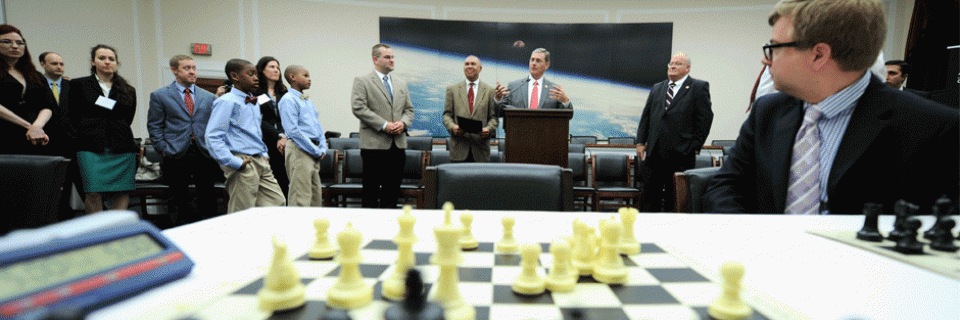
A resolution recognizing Saint Louis as the "National Chess Capital" was introduced on the floor of the Senate in April.
SAINT LOUIS, May 6, 2014 – On the eve of hosting the most prestigious chess tournaments in the nation, St. Louis received national recognition from the United States Senate, which passed an official resolution late Monday night naming St. Louis the National Chess Capital.
The resolution, which was introduced by Senators Claire McCaskill (D-MO) and Roy Blunt (R-MO), also seeks to raise awareness of the educational benefits of chess and to encourage schools and community centers to engage in chess programs that promote important developmental skills like problem-solving, critical thinking, spatial awareness and more.
"The Chess Club and Scholastic Center of Saint Louis hosts all major U.S. chess competitions and has been a driver in educating children throughout the State since its inception," Senator McCaskill said. "The intellect and creativity needed to learn and compete in chess also helps students think creatively and strategically in traditional academic areas, including math and science. We are proud St. Louis is leading the way in competitive American chess while providing students the problem-solving and critical thinking skills needed in an ever-advancing world."
“I’m pleased the Senate approved our resolution to designate St. Louis as the National Chess Capital,” Senator Blunt said. “Chess programs like those offered by the Chess Club and Scholastic Center of Saint Louis challenge young people academically and help motivate them to succeed."
The news comes just days after the announcement that a Congressional Chess Caucus has been formed to promote the educational benefits of chess and just days before the top chess players in the country will compete in St. Louis for the title of U.S. Champion and U.S. Women’s Champion.
The 2014 U.S. Championship and 2014 U.S. Women’s Championship will begin May 7 and continue through May 20 at the Chess Club and Scholastic Center of Saint Louis (CCSCSL).
This marks the sixth consecutive year that each of these prestigious events will be held in St. Louis. The opening ceremony takes place At the World Chess Hall of Fame on May 7 at 6 p.m., and the first round for both events will kick off at 1 p.m. on May 8.
The 2014 U.S. Championship will feature a 12-player round robin and a guaranteed total prize fund of $172,000. The winner will take home $45,000.
In addition, the CCSCSL is sponsoring a “$64,000 Fischer Prize,” to be awarded to anyone who wins all 11 of their games outright without a single draw or defeat. The prize is named in honor of the 50th anniversary of Bobby Fischer’s accomplishment of that feat -- the only time anyone has ever done it -- at the 1963-64 U.S. Championship.
Last year, Grandmaster Gata Kamsky of New York City won his fourth U.S. Championship title. Kamsky, 39, seeks to defend his title this year against 11 strong competitors.
The 2014 U.S. Women’s Championship will feature 10 players and a guaranteed prize fund of $72,000. Grandmaster Irina Krush, 30, of New York City looks to defend her U.S. Women’s Championship crown.
Tony Rich, executive director of the CCSCSL, said these tournaments provide a learning opportunity for spectators and create role models for students of the game.
“Chess offers developing students a wide array of benefits including critical thinking, planning and sportsmanship, just to name a few,” Rich said. “Hosting these events allows us to showcase the top players in the country and also tell the world about the fantastic educational benefits chess can offer.”
Annual members of the Chess Club can attend the event for free, and annual membership to the CCSCSL costs just $50 for students or $100 for adults. Tickets for individual rounds of the event are available for $10 per day.
In addition, the CCSCSL is hosting a free student weekend May 17 and May 18, which will waive the $10 ticket price for all K-12 students.
For more information on the players and the U.S. Championships, visit www.uschesschamps.com.
WGM Jennifer Shahade and GM Yasser Seirawan will join GM Maurice Ashley (not pictured) to provide live commentary for the 2014 U.S. Championships.
SAINT LOUIS, April 14, 2014 -- Next month, the top chess players in the country will meet in Saint Louis to compete for the tile of U.S. Champion and U.S. Women’s Champion.
The fields are set for both the 2014 U.S. Championship and 2014 U.S. Women’s Championship, scheduled to be held simultaneously May 7 through May 20 at the Chess Club and Scholastic Center of Saint Louis (CCSCSL).
Ashritha Eswaran, 13, received the final wildcard invitation to the U.S. Women’s Championship to round out the fields.
This marks the sixth consecutive year that each of these prestigious events will be held in Saint Louis. The opening ceremony takes place on May 7, and the first round for both events will kick off at 1 p.m. Central on May 8.
The 2014 U.S. Championship will feature a 12-player round robin and a guaranteed prize fund of $172,000. In addition, the CCSCSL again will sponsor the “$64K Fischer Prize,” to be awarded to anyone that scores a perfect 11-0 in the U.S. Championship, in honor of Bobby Fischer’s result at the 1963-64 U.S. Championship.
GM Hikaru Nakamura declined his invitation to play in this year’s event, citing his desire to prepare for and compete against the world’s elite as he prepares for a run at the next Candidate’s cycle.
Tony Rich, executive director of the CCSCSL, said the competition will be fierce.
“Any one of these players has a shot at the title this year,” Rich said.
The complete list of players, and their current USCF ratings, for the 2014 U.S. Championship is as follows:
- GM Gata Kamsky (2778)
- GM Timur Gareev (2751)
- GM Alex Onischuk (2751)
- GM Varuzhan Akobian (2732)
- GM Sergey Erenburg (2717)
- GM Ray Robson (2714)
- GM Sam Shankland (2698)
- GM Alex Lenderman (2693)
- GM Alejandro Ramirez (2679)
- GM Mac Molner (2634)
- GM Daniel Naroditsky (2632)
- GM Josh Friedel (2599)
The 2014 U.S. Women’s Championship will feature 10 players and a guaranteed prize fund of $72,000. GM Irina Krush looks to defend her U.S. Women’s Championship crown. The field for the 2014 U.S. Women’s Championship is as follows:
- GM Irina Krush (2548)
- IM Anna Zatonskih (2526)
- WGM Tatev Abrahamyan (2475)
- WGM Camilla Baginskaite (2358)
- WIM Iryna Zenyuk (2352)
- WGM Sabina Foisor (2303)
- WIM Viktorija Ni (2302)
- WGM Katerina Nemcova (2297)
- FM Alisa Melekhina (2251)
- NM Ashritha Eswaran (2231)
“The U.S. Women’s Championship features seasoned veterans along with some exciting new faces as well,” Rich said. “I’m excited the Chess Club gets to showcase so many inspiring role models for Saint Louis area students.”
The well-established commentary team of GM Maurice Ashley, GM Yasser Seirawan and WGM Jennifer Shahade will once again offer Internet viewers live play-by-play and analysis for each round of the event. GM Robert Hess will join GM Ben Finegold to provide commentary for the live audience in Saint Louis.
Carol Jarecki will serve as the chief arbiter for both events.
Check this website the latest updates, full player bios, info about past U.S. Championships and news about the top players in the U.S.

GM Gata Kamsky and GM Irina Krush each will look to defend his and her respective titles at the 2014 U.S. Championships in Saint Louis.
Note: The Closing Ceremony of the U.S. Championships is May 20. The initial draft of this press release listed May 21 as the final day. The U.S. Junior Championship will take place June 19-29.
SAINT LOUIS (January 15, 2014) -- The best chess players in the U.S. will gather in Saint Louis once again to fight for the title of U.S. Champion and U.S. Women’s Champion.
For the sixth consecutive year Saint Louis will host the top chess tournaments in the nation.
GM Gata Kamsky will defend his title at the 2014 U.S. Championship while recently anointed Grandmaster Irina Krush will look for her sixth title at the 2014 U.S. Women’s Championship. The events will be held simultaneously May 7 through May 20 at the Chess Club and Scholastic Center of Saint Louis (CCSCSL).
The U.S. Junior Closed Championship also will be held in Saint Louis once again from June 20 through July 3. This marks the fifth consecutive year the CCSCSL has hosted the top event in the nation for players under the age of 20.
Tony Rich, executive director of the CCSCSL, said he is excited to continue the long-standing and growing tradition of U.S. Championship chess in Saint Louis.
“Since 2009, we’ve worked to raise the prominence and profile of the U.S. Championships,” Rich said. ”We’re honored the U.S. Chess Federation once again awarded these prestigious events to Saint Louis, and we hope our U.S. Champions will continue to serve as role models for young chess players across the country.”
These three events are the most prominent invitational tournaments in the nation, and the players will be competing for more than a quarter of a million dollars in prize money.
2014 U.S. Championship
- Dates: May 7-20, 2014
- Format: 12-player Round Robin
- Prize Fund: $172,000 plus $64k Fischer Bonus (breakdown to be published soon)
- Invitations:
- 2013 U.S. Champion: Gata Kamsky
- 2013 U.S. Junior Closed Champion: Daniel Naroditsky
- 2013 U.S. Open Champion: Josh Friedel
- (1) - Wildcard (TBD)
- (8) - Rating (TBD - March supplement)
2014 U.S. Women's Championship
- Dates: May 7-20, 2014
- Format: 10-player Round Robin
- Prize Fund: $72,000 (breakdown to be published soon)
- Invitations:
- 2013 U.S. Women's Champion: Irina Krush
- (2) - Wildcard (TBD)
- (7) - Rating (TBD - March supplement)
2014 U.S. Junior Closed Championship
- Dates: June 19-29, 2014
- Format: 10-player Round Robin
- Prize Fund: $10,000 (breakdown to be announced soon)
- Invitations:
- (1) - 2013 U.S. Junior Closed Champion (Daniel Naroditsky)
- (1) - 2013 U.S. Junior Open Champion (Justus Williams)
- (2) - Wildcard (TBD)
- (6) - Rating (TBD - April rating supplement)
For the U.S. Championship, the CCSCSL once again will sponsor the “$64K Fischer Prize,” to be awarded to anyone that scores a perfect 11-0, in honor of Bobby Fischer’s similar accomplishment at the 1963-64 U.S. Championship.
Stay tuned for the latest updates about the U.S. Championships.
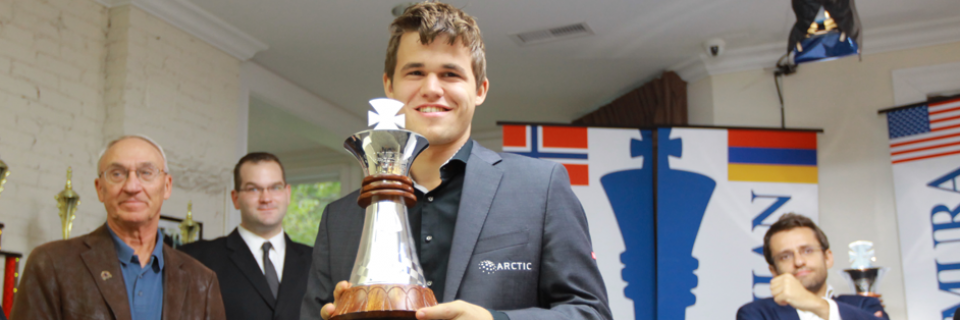
Event sponor Rex Sinquefield and tournament organizer Tony Rich presented GM Magnus Carlsen the trophy for the inaugural Sinquefield Cup. World No. 2 Levon Aronian looks on.
By Brian Jerauld
Games annotated by GM Varuzhan Akobian and GM Ronen Har-Zvi
SAINT LOUIS (September 16, 2013) -- World No. 1 Magnus Carlsen brought home a $70,000 souvenir after his first visit to the United States: The country’s finest prize in chess, the Sinquefield Cup.
But he left America with an encore that made every last penny count.
With the showdown between U.S. No. 1 Hikaru Nakamura and reigning U.S. Champion Gata Kamsky already adjourned in a draw, Carlsen sat just a half-point away from the tournament’s top prize – and in front of a deadlocked board opposite World No. 2 Levon Aronian.
Aronian, trailing by a point, would earn third place and $30,000 regardless of a loss or draw – though a win promised playoffs. So he decided to probe the impossible-looking position while Carlsen, his own pieces frozen in tension, seemed content to wait the Armenian out. The white king moved idly back and forth on the back rank, waiting for Aronian to look the other way.
And he did – just the slightest. Aronian’s pressing, through a series of weakening king moves, tipped Carlsen just the smallest of advantages. And when Aronian decided he could find no way into the white camp, he offered a draw – and to everyone’s shock, Carlsen denied it. The half-point would have earned first place outright, $70,000 and the inaugural Cup, but Carlsen had found something much more valuable: the path to victory.
The win padded his lead to a full point (4.5/6), closing the strongest tournament on American soil with a dazzler. Nakamura (3.5/6) was forced to settle for the second place prize of $50,000 after his draw with Kamsky (1.5/6) on Sunday afternoon added no pressure to Carlsen.
“The final margin of victory was a little flattering,” Carlsen said.
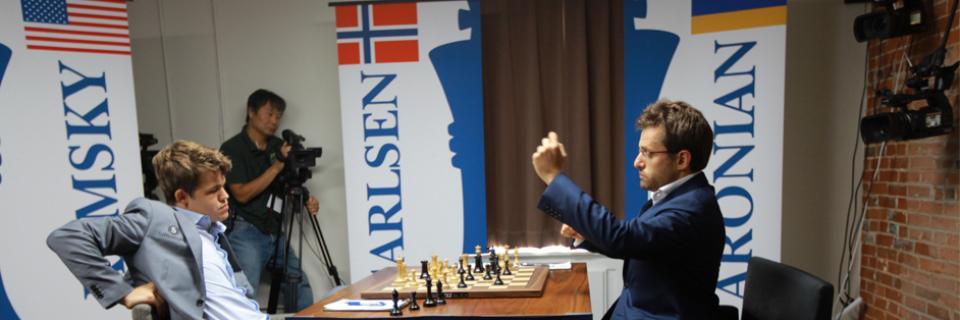
World No.1 GM Magnus Carlsen declined a draw offer even though it would have guaranteed him clear first place. He went on to win his round 6 matchup agisnt World No. 2 GM Levon Aronian.
Aronian is a specialist in 1…e5, and his expert familiarity with the defense left him remarkably comfortable on the clock. Carlsen, however, would be struggling with the clock as the players neared the time control. Carlsen’s 14. Bc4 lost a step, and Aronian applied pressure immediately with 14…Ng4, forcing white to defend. Black’s position looked awkward (not aided by 16. Bxe6 fxe6, which doubled his pawns), but Aronian’s position had surprising potential.
His 28…Nbxa5 netted the game’s first material advantage, though the pawn grab came with a hint of poison as both knights and one of black’s rooks became locked in a defensive fortress, forcing the board into a near-static position. By 40. Kg1, Carlsen had worked himself out of time pressure and remained idle behind his own stout set up.
But after time control, despite no available pawn breaks and a host of immobile pieces for black, Aronian spent his extra time probing for weaknesses – a task that eventually weakened his own position. When he conceded that there was no path to Carlsen’s king, he offered a draw after 47…Kb7 – but received 48. Nd1 instead of the handshake.
Carlsen came quick with the attack, first relocating his cavalry to 51. Nc4. It pried open the black fortress and chased away both rooks with 52. bxc4 and 53. c5 before decimating the queenside pawns. Already on a slippery slope, Aronian made several more missteps down the stretch, including 54…b3, a move that did little more than sacrifice his knight with 55. Rxc6. The game was lost, though it continued into futility: Aronian resigned after 70. Ne5.
Carlsen-Aronian annotated by GM Varuzhan Akobian
Nakamura needed help from Aronian on the other board, but his final-round draw against Kamsky – a half-point that wasn’t easy to claim – didn’t help his own cause.
Seeking a full point, he answered Kamsky’s 1. e4 with the Najdorf, showing early aggression at 14…g4. The attack on the white castle seemed premature, however, with not much of black’s upper army seemingly ready to fight. Kamsky, showing a bit of polish after a rough week, had stuck to his principles with a king harbored in safety and a stout front line.
Though it is Nakamura who prefers the razor’s edge, Kamsky introduced some sharpness into the game with 19. f4 and 20. e5, looking to crack open black’s center line with its king still uncastled.
Nakamura’s 24…Qb6+ seemed a question mark in the American’s calculation, a first sign that a black victory was slipping out of view - and maybe worse on the horizon. But Kamsky let his advantage slip away with 29. Rd1?, not capitalizing on Nakamura’s distressed king, and the game soon adjourned in repetition.
Kamsky-Nakamura annotated by GM Ronen Har-Zvi
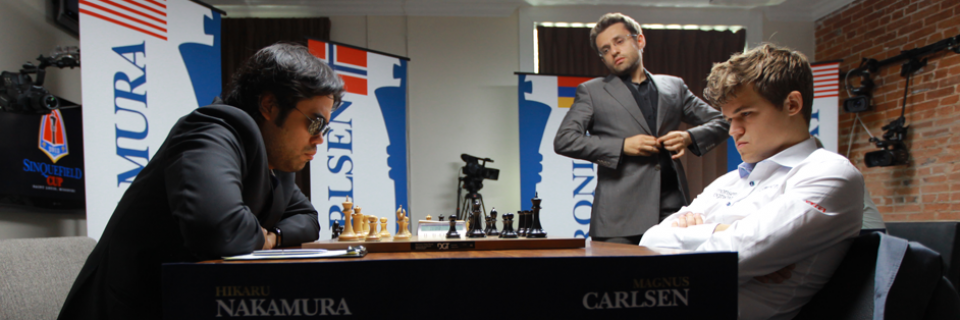
GM Hikaru Nakamura, GM Levon Aronian and GM Magnus Carlsen all have chances at winning the inaugural Sinquefield Cup.
By Brian Jerauld
Game annotations by GM Ben Finegold and GM Ian Rogers
SAINT LOUIS (September 14, 2013) -- There’s just one round left in the strongest tournament ever held on American soil—one game to play for the Sinquefield Cup.
After draws on both boards on Saturday, including a pivotal match between frontrunner Magnus Carlsen (3.5/5) and Hikaru Nakamura (3.0/5), the tournament standings remain the same. Levon Aronian (2.5/5) stays within striking distance of both leaders, and the result of his impending Sunday morning duel with Carlsen could play out to several storylines.
The two played to a draw in their first meeting on Tuesday. Nakamura seeks his second win against Gata Kamsky (1.0/5), who looks to play spoiler with the white pieces.
It is no secret that Kamsky is having a rough stay in Saint Louis. So if you can’t beat ‘em, join ‘em.
The reigning U.S. champ united with the newly popular theory that Aronian’s 1.d4 needed some work against the Dutch defense, a secret that Carlsen had revealed with great effect in round 2. Last Tuesday, Aronian had quickly lost white’s edge against Carlsen’s Dutch, falling into a middlegame that offered him no initiative and a grueling path to a draw.
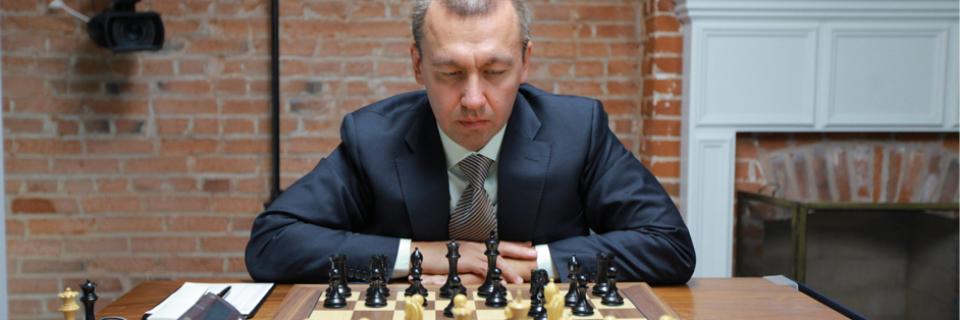
GM Gata Kamsky jumped on the bandwagon, employing the Dutch against GM Levon Aronian in round 5.
It was a decent enough idea for Kamsky, who is seasoned in the Dutch and was yearning for a balanced game of chess in the Sinquefield Cup. He looked to lean on an advantage where Carlsen could not.
“I’ve played the Dutch for a number of years now; it’s an interesting opening. If white screws up, he can possibly get in a worse position,” Kamsky said. “I’m curious why [Aronian] defensed this Bf4 set up. After the game, of course, it was justified, but I don’t think white has such a serious advantage by playing this line.”
Indeed, 5. Bf4 was a questionable move against Kamsky, just as it had been against Carlsen. The improvement on Saturday afternoon, however, came at 8.Bg3, a move that did avoid the tactical mess that Carlsen had introduced, but still did little to prevent black equality. Kamsky earned himself the bishop pair with 10…Nxg3.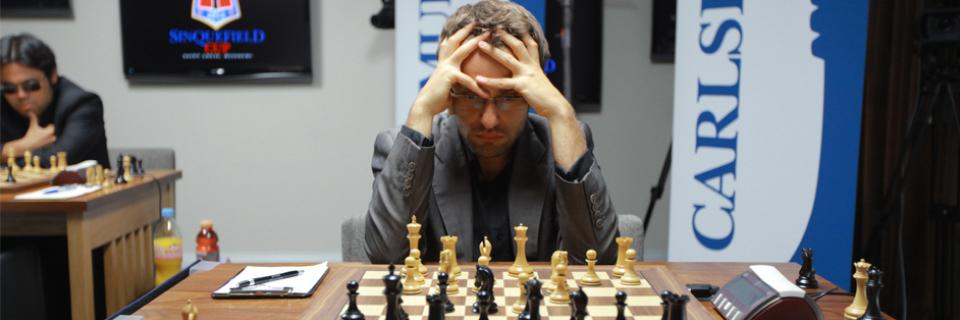
GM Levon Aronian controls his own fate as he squares off against GM Magnus Carlsen, the tourney leader, in the final round.
By the middlegame, the American was pushing with initiative, ultimately introducing the clever 27…Qf6. The interesting double attack threatened Aronian both in material, via a queen-rook skewer, as well as position, setting up for the h4 break. It baffled Aronian, who went into a deep think on his response, at a time when his clock wasn’t forgiving. It fell below ten minutes before he decided on 28. Nxh5.
“I couldn’t really see a good way for me to play,” Aronian said. “I’m not sure [28. Nxh5] was the best move, but I felt that at least there is some simplification, and I thought, ‘I’m not getting ‘mated, so I shall play that one.’”
It worked, though not without drama. The pawn grab did little more than open up the h-file and a direct lane to the white monarch, an exploit that Kamsky pressed immediately. A rook-and-queen battery briefly brought the leading lady too close for comfort, though ultimately into a futile position. The queens and eventually rooks were traded, leaving the curse of the opposite-colored bishops. The game drew on the 44th move.
Aronian - Kamsky annotated by GM Ian Rogers
Though the Sinquefield Cup has already featured five wins through ten games, Saturday’s Nakamura-Carlsen tilt was what most might expect from a super tournament: Two of the world’s elite, refusing to give an inch. The draw-by-repetition served as the quickest match of the tournament, only 32 moves, and featured a delicate balance of the smallest advantages.
Perhaps the only prize Nakamura could grab from Carlsen’s Berlin defense was the bishop pair, moving his queen’s knight six times to achieve 15. Nxc8. Nakamura brought the game into new territory with 16. g3, though it was Carlsen who pressed the issue with 22…f4.
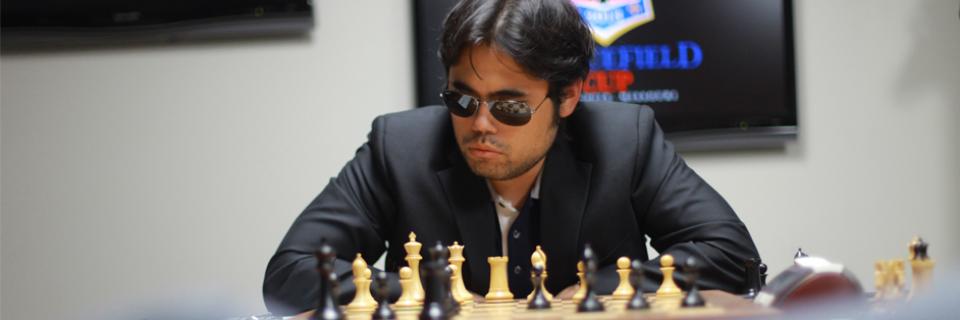
GM Hikaru Nakamura donned shades once more in his tilt against GM Magnus Carlsen, but his first victory against the World No. 1 remained elusive.
“I thought that I might be a little bit better, but I think it’s a question of whether this whole idea of f4 works or doesn’t,” Nakamura said. “Unfortunately, at the end, he was able to bail out.”
Clearly, f4 did not work to anyone's favor. Though it looked precarious, the attack found no future, and Nakamura simply chased Carlsen’s queen into repetition.
“I’m usually not too unhappy with a draw with black against such strong players,” Carlsen said. “I was kind of hoping he would over-press, and at the end I decided not to play out of a draw ... because I was hoping he would play on and play for a loss. But obviously he’s much too good of a player to screw it up.”
Nakamura - Carlsen annotated by GM Ben Finegold
Standings After Round 5
| No. | Name | Rating | Total |
|---|---|---|---|
| 1 | Magnus Carlsen |
2862 |
3.5 |
| 2 | Hikaru Nakamura |
2772 |
3 |
| 3 | Levon Aronian | 2813 | 2.5 |
| 4 | Gata Kamsky | 2741 | 1 |
Pairings for Round 6 - 09/15/2013
| No. | White | Rating | Result | Black | Rating |
|---|---|---|---|---|---|
| 1 | Carlsen, Magnus |
2862 |
- | Aronian, Levon |
2813 |
| 2 | Kamsky, Gata | 2741 | - | Nakamura, Hikaru |
2772 |

World No. 1 Magnus Carlsen took over sole posession of first place by besting the reigning U.S. Champ Gata Kamsky in round 4. Carlsen was exhausted after the game.
By Brian Jerauld
Games Annotated by GM Varuzhan Akobian and GM Ronen Har-Zvi
SAINT LOUIS (September 14, 2013) -- It was another round of fighting chess and another day of decisive results at the inaugural Sinquefield Cup. The event, held at the Chess Club and Scholastic Center of Saint Louis, now features five wins through eight games.
Friday’s fourth-round victories were good enough to rattle the overall standings: World No. 1 Magnus Carlsen toppled an uninspired Gata Kamsky to move into clear first with 3/4, as Hikaru Nakamura lost his leader-status after stumbling out of the gate against Levon Aronian. The loss brings Nakamura into second place with 2.5/4, while Aronian has climbed back into the tournament with 2/4. Kamsky has a half-point through four rounds.
After his game, Nakamura expressed clear displeasure with his opening choices, highlighting 7. … a6 and 8. … b5 in his King’s Indian Defense as poor decisions. A questionable 10. … h6 also proved to be a dog that would bite him later in the game.
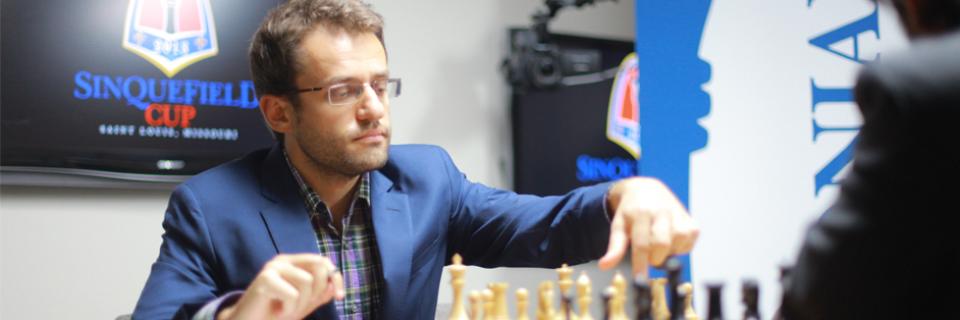
GM Levon Aronian crept back into contention with a victory tourney leader GM Hikaru Nakamura.
After Nakamura took his king’s knight on a queenside run from f6-e8-c7-a6, ultimately finding a cozy outpost with 17. … Nb4, Aronian offered an interesting relocation of his own cavalry with 19. Ne2. He followed with 20. h4, the first charge toward the black monarch.
He was not met with adequate resistance. Nakamura answered with 20. … c4, which opened the fight on the queenside but allowed Aronian to push a pawn to the pivotal h5 square. White instantly took the advantage, ushering a desperation sacrifice from Nakamura with 23. … N6xd5, trading his minor piece for both of white’s center pawns with the hope for some counterplay.
“[Nakamura] had to do it,” Aronian said of the sacrifice. “It was hopeless for black, but any way was hopeless ... of course, I should have played Qd1 after Bd5, and then just win by attacking his king – an extra piece helps, normally.”

GM Levon Aronian's defeat of GM Hikaru Nakamura helped allowed GM Magnus Carlsen to grab hold of clear first after four rounds.
Indeed, Aronian’s selection of 25. Rxc8, instead of dropping his queen to safety, left some light in Nakamura’s tunnel. The American quickly traded queens off the board.
“Levon tends to do this quite often,” Nakamura said of the queen trade. “He gets in these winning positions and doesn’t convert them in time or makes them very difficult. … It’s not the first time. It gave me some practical chances, but it’s not like I was playing a weak player.”
Aronian converted his winning position just fine. After picking up an extra pawn with 37. Nxe5, the minor piece endgame served as a masterful display of technique for the World No. 2, who executed down the stretch of the longest game of the Sinquefield Cup thus far. The American conceded on the 61st move.
“Overall, just a bad decision in the opening to try and play this a6-b5 gambit,” Nakamura said. “All credit to Levon for playing well. I should have made better decisions in the opening and made them out to work, at least, instead of just giving him a free point.”
Aronian-Nakamura annotations by GM Varuzhan Akobian
Kamsky had found his way into several decent positions through the first cycle of the tournament, perhaps only imploding after some admitted over-aggression, but on Friday he never found comfort.
He attacked Carlsen with the exchange Ruy Lopez and took the game down an uninspiring line, which was quite unlike the aggressive Kamsky from the start of the tournament. Not waiting around, Carlsen’s 14. … Ng4 gave the game the flair it needed as he eyed the h2 pawn.
Kamsky lost more than a tempo with a questionable 17. Nd2 and, by 18. … Bg3, Carlsen’s army was dangerously active on the open board while white sat uncomfortably undeveloped. Desperate to activate, Kamsky pushed 22. c3?, essentially sacrificing the pawn with nothing to show.

GM Magnus Carlsen squandered an early advantage with inaccurate play, but ultimately converted the win against GM Gata Kamsky.
For a while, however, it appeared Kamsky, who had fought valiantly down the stretch in his first-round tilt with Carlsen, might hold the draw. The Norwegian did not display his standard razor sharpness, choosing an uncertain path through the middle game that allowed white to hunker down.
Carlsen’s 45. … Rxd2+, which appeared to push toward a bishop endgame with no clear lines to victory, looked like the antidote Kamsky needed – but 50. Bc3?? was a clunker. Carlsen was quick to march his b-pawn with tempo, eventually creating passers on both wings and then challenging the remaining bishop for the important a1-h8 diagonal.
“At some point I lost control, but fortunately it was enough,” Carlsen said. “Today, in the fourth hour of play, I was playing so badly. The same against Levon the other day: hesitating and burning huge amounts of time.”
Kamsky-Carlsen annotations by GM Ronen Har-Zvi

